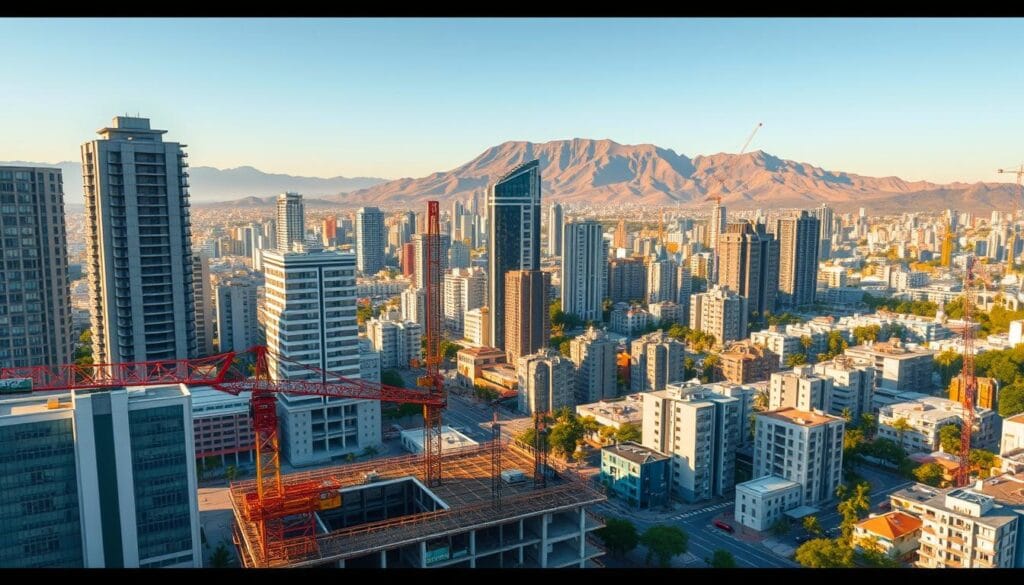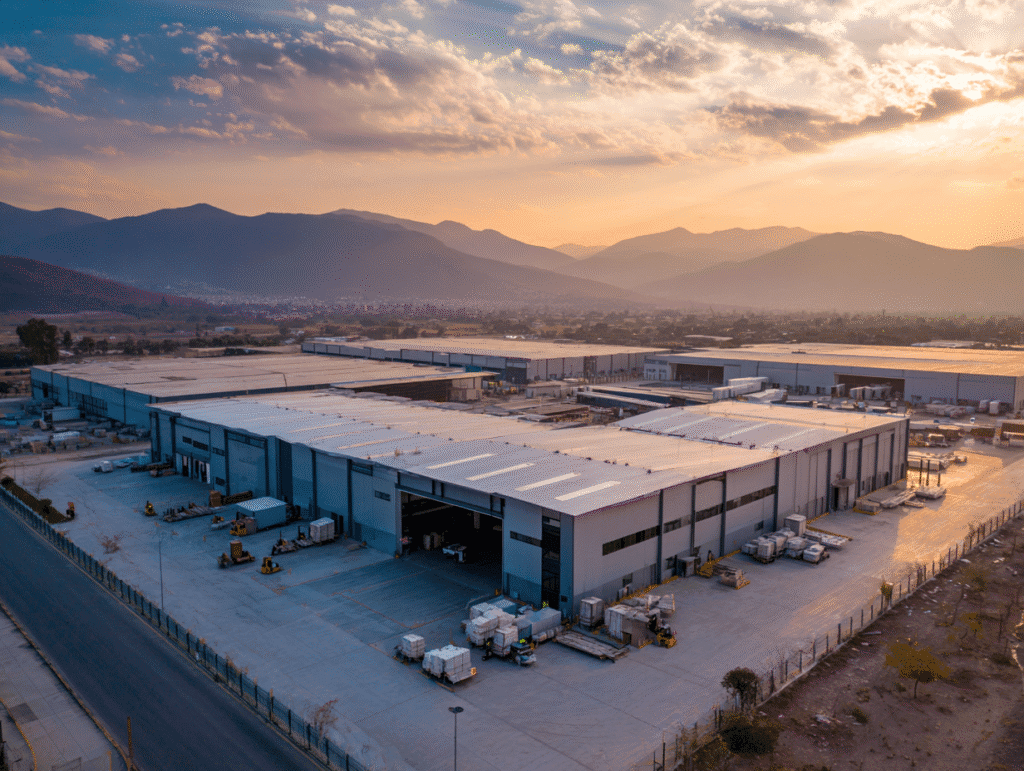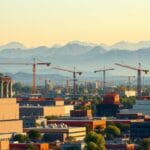The Bajio is in motion. Across Querétaro, Guanajuato, Jalisco, San Luis Potosí, and Aguascalientes, regional leaders formed the Centro-Bajío-Occidente Alliance (ACBO) to coordinate big-ticket works that sharpen competitiveness. This push, backed by Coparmex, is turning Bajio real estate development into a magnet for capital while supporting steady Bajio economic growth.
Early steps are concrete. Federal funds of 26 million pesos support pre-investment studies for a high-speed rail link between Guanajuato and Querétaro, with future extensions toward Jalisco and Aguascalientes. The alignment would tie León, Silao, Irapuato, Salamanca, Celaya, and Apaseo El Alto to Querétaro. Estimated construction for the segment runs 20–25 billion pesos, not counting a separate Mexico State connection once priced by the SCT at 50.8 billion pesos.
Road and air upgrades round out the picture. Guanajuato plans to widen the San Felipe–Silao highway to four lanes and a new Querétaro–Guanajuato corridor is on the table, both vital for freight. In Jalisco, Grupo Aeroportuario del Pacífico is investing 12 billion pesos at Guadalajara International Airport for a second runway and a new terminal, deepening cross-border connectivity.
Water security also factors into site decisions. The El Zapotillo dam and aqueduct would transfer water from Jalisco to León, with an allocation split under review by Conagua. As logistics and nearshoring scale up, CBRE and MBN report 14.4 million m² of industrial stock in the region with 4% annual growth led by Querétaro and Guanajuato, while AMPIP’s Plan México backs 100 new industrial parks nationwide.
For U.S. investors, these Major Infrastructure Projects Driving Bajio Industrial Real Estate signal durable demand and a clearer path to execution. With projects maturing across corridors and airports, the foundation for Bajio real estate development is solid, and policy coordination points to sustained Bajio economic growth.
Overview of Bajio’s Industrial Landscape
The Bajio is a production hub that links Querétaro, Guanajuato, Jalisco, San Luis Potosí, and Aguascalientes. This network forms the Bajio industrial corridor, where logistics, talent, and energy access meet. Investors track how industrial real estate Bajio supports nearshoring and modern supply chains.
Regional coordination matters. ACBO promotes integrated mobility and sustainability to keep freight moving within and across states. As manufacturing in Bajio expands, coordinated planning reduces bottlenecks and raises operational certainty.
The Importance of Bajio in Mexico’s Economy
Market data from MBN and CBRE shows 14.4 million m² of industrial stock with 4% year-over-year growth. Demand clusters in Querétaro and Guanajuato lead, with Aguascalientes gaining pace. This reflects national trends where e-commerce and nearshoring drive leasing and park development.
By 2025, former Prologis CEO Luis Gutiérrez expects logistics firms to take about two-thirds of new park demand. With online retail near 15% of sales in Mexico, compared with roughly 30% in other markets, the region has room to grow. The Bajio industrial corridor is set to capture that momentum.
Developers blend build-to-suit and speculative projects, according to CBRE. A 55% share for tailored facilities and 45% speculative signals balanced appetite. This mix strengthens the base for industrial real estate Bajio across core transport routes.
Key Industries Benefiting from Growth
Automotive and auto parts anchor manufacturing in Bajio. Plants across the five states feed cross‑border supply chains and leverage proximity to the United States. Fast links help suppliers shorten cycle times and stabilize inventory.
Aerospace benefits from skilled labor in Querétaro and improved connectivity, as noted by AMPIP. Medical devices and logistics also rank as priorities for new park development. These segments align with the capabilities of the Bajio industrial corridor.
In Jalisco, ProximityParks and Arca Continental invested US$86.6 million to scale logistics capacity. ProximityParks launched Guadalajara Centro at 17,930 m² for last‑mile operations. It processed more than 1.5 million packages in its first three months, enabling same‑day delivery.
| State | Primary Strength | Recent Momentum | Relevance to Investors |
|---|---|---|---|
| Querétaro | Aerospace, advanced manufacturing | High demand clusters; skilled labor base | Build-to-suit potential for precision parts and MRO |
| Guanajuato | Automotive and auto parts | Stable supplier networks, nearshoring wins | Core node for industrial real estate Bajio leasing |
| Jalisco | Logistics and e-commerce | Last‑mile expansion in Guadalajara | Speculative space for rapid fulfillment growth |
| San Luis Potosí | Automotive hubs and distribution | Connectivity to Mexico City and border routes | Strategic link within the Bajio industrial corridor |
| Aguascalientes | Manufacturing scale-up | Rising activity noted by CBRE | Emerging sites for manufacturing in Bajio |
Major Infrastructure Developments
The Bajio is moving fast on projects that cut travel times, open new sites, and smooth freight flows. With a wave of infrastructure projects Bajio in motion, companies gain clearer timelines and better cost control. These upgrades knit together factories, suppliers, and ports through stronger logistics infrastructure Bajio that serves nearshoring demand.

Highways and Transportation Improvements
The 63 km San Felipe–Silao highway in Guanajuato is slated to expand from two to four lanes at about 1.7 billion pesos. This link is a key spine between León, Silao, and Irapuato and supports east–west freight. As part of transportation projects Bajio, the upgrade eases peak congestion and gives shippers more reliable schedules.
A new cross-state highway from Querétaro to Guanajuato is on the docket. While construction details are pending, the route would unlock added capacity for commuter traffic and heavy trucks. It also complements planned rail links and widens site options for suppliers.
Studies are funded for a high-speed rail corridor tying Mexico State, Querétaro, and Guanajuato, with future reach to Jalisco and Aguascalientes. The Guanajuato–Querétaro segment carries a projected build of 20–25 billion pesos, with 26 million pesos already set for studies. The alignment would connect León, Silao, Irapuato, Salamanca, Celaya, and Apaseo El Alto to Querétaro, boosting passenger mobility that sits adjacent to cargo nodes and spurring transit-oriented industrial hubs. Earlier plans for Mexico–Querétaro (2014) envisioned a three-track, 14-station line and are likely to be updated under a PPP model.
New Industrial Parks and Facilities
Developers under AMPIP’s Plan México are deploying US$5 billion for 100 new parks. Since October 2024, 13 parks have broken ground with US$626 million in initial spend. These sites span aerospace, automotive, medical, and logistics, pairing heavy electrical capacity for manufacturing with layouts built for high-volume fulfillment—core to logistics infrastructure Bajio.
The Bajío Industrial Park in Zinapécuaro, Michoacán, is the first “Economic Development for Wellbeing” hub. At 342 hectares, it links rail, road, and port corridors to attract both national and international capital. The park is designed to anchor supply chains and create high-value jobs across the broader region.
In the Guadalajara metro, led by El Salto, developers reactivated more than 190,000 m² of speculative space. By end-1Q25, El Salto alone had 168,000 m² under construction, with 20,000 m² started in the quarter and over 30,000 m² slated for 2Q. This surge answers tight vacancy and supports light manufacturing and urban logistics, aligning with transportation projects Bajio that reduce last-mile friction.
The Role of Airports in Connectivity
Grupo Aeroportuario del Pacífico is advancing a 12 billion-peso expansion at Guadalajara International Airport. A second runway, new platforms, and a new terminal position the site as a logistics and passenger hub for Jalisco and the Bajio. The result is faster turnarounds for high-value cargo and dependable links for executive travel tied to nearshoring.
Federal efforts to modernize ports and airports are also improving multimodal performance. ANAM reports fluid operations at Manzanillo, with 87.4% clearance of pending shipments after inspection. Better customs throughput at the coast supports inland distribution and strengthens infrastructure projects Bajio that depend on synchronized road-air-sea flows across logistics infrastructure Bajio.
Discover Bajio tracks construction timelines, right-of-way status, and utility provisioning to help investors align plant ramps with hard-infrastructure milestones, lowering risk across transportation projects Bajio.
Impact on Real Estate Investment
Investors are pivoting to the heart of Mexico’s supply chain. As Bajio economic growth accelerates, capital targets corridors that convert speed into value. This shift places Bajio real estate development at the center of cross-border trade and fast e-commerce cycles within the industrial real estate Bajio market.

Trends in Industrial Property Demand
Nearshoring, e-commerce, and logistics reconfiguration now set the pace for leasing. CBRE notes that logistics users are on track to represent about two-thirds of new industrial park demand in 2025, edging past traditional manufacturing. That tilt is already visible in industrial real estate Bajio, where users prize speed to customer and resilient networks.
Pipelines reflect rising confidence. In Mexico City, roughly 55% of projects are Built-to-Suit versus 45% speculative, signaling a willingness to build ahead of signed tenants. Similar ratios inform Bajio real estate development along routes feeding Guadalajara, Querétaro, and Guanajuato, compressing delivery timelines and supporting higher pre-leasing.
Regional signals are firm. The Bajio’s 14.4 million m² stock, up about 4% year over year, shows steady absorption and thin availabilities. With national pre-leasing near 60% in select launches like Monterrey, tenants in Bajio submarkets are moving earlier to secure space, a trend that underscores Bajio economic growth.
How Infrastructure Influences Property Values
Transportation upgrades change the math. The San Felipe–Silao expansion and the Querétaro–Guanajuato connector cut travel times and freight costs, lifting rents and land values near interchanges. Assets with direct highway egress lease faster and often price at a premium, strengthening Bajio real estate development pro formas.
Rail and airports add reach. High-speed rail planning can re-rate land near future stations by improving labor access and executive mobility. In Jalisco, Guadalajara’s second runway and terminal raise air cargo capacity, supporting aerospace, medical devices, and electronics—sectors that pay more for Class A space within 45–60 minutes, fueling Bajio economic growth.
Utilities move the needle. The El Zapotillo water project, aimed at León and Guadalajara, underpins heavier-use manufacturing, shaping Built-to-Suit terms and long-horizon valuations. Policy also matters: AMPIP’s Plan México pipeline increases institutional-grade supply, where parks tailored for power-heavy production or high-throughput logistics command distinct pricing in industrial real estate Bajio.
Bottom line for underwriting: aligning infrastructure milestones with demand drivers clarifies rents, TI allowances, and absorption timelines, helping identify micro-markets across the Bajio corridor with potential to outperform.
| Driver | Market Signal | Likely Impact on Values | Implication for Investors |
|---|---|---|---|
| Highway Upgrades (San Felipe–Silao, Querétaro–Guanajuato) | Faster freight, direct egress sites lease first | Rent premiums near interchanges | Prioritize land with on/off-ramp access for Bajio real estate development |
| Airport Expansion (Guadalajara runway and terminal) | Higher air cargo throughput, global routes | Class A rate lift within 45–60 minutes | Target time‑sensitive users to capture Bajio economic growth |
| Nearshoring & E‑commerce Demand | Logistics users ~2/3 of new take-up | Compressed vacancy, faster lease-up | Blend speculative and BTS in industrial real estate Bajio |
| Utilities & Water Security (El Zapotillo) | Support for heavier-use manufacturing | Higher BTS valuations, longer terms | Underwrite power/water capacity premiums |
| Institutional Park Pipeline (AMPIP Plan México) | More Grade A options, specialized layouts | Price differentiation by spec vs. BTS | Match asset design to corridor demand nodes |
Discover Bajio: Your Partner in Investment
Discover Bajio helps U.S. investors act on Major Infrastructure Projects Driving Bajio Industrial Real Estate. Our team connects market data with field checks across Querétaro, Guanajuato, Jalisco, San Luis Potosí, Aguascalientes, and adjacent hubs like Michoacán’s Bajío Industrial Park in Zinapécuaro. We track infrastructure projects Bajio in real time, align sites with utilities and labor, and stress-test hold periods against logistics infrastructure Bajio upgrades.
Contact Us for Investment Opportunities
Discover Bajio offers portfolio strategy, market entry, brokerage, and development advisory across the Bajio corridor.
Connect to identify high‑conviction assets matched to your risk and return goals. We align timing with infrastructure projects Bajio and the logistics infrastructure Bajio network so your portfolio captures the next wave of growth with disciplined underwriting and clear execution paths.

Discover Bajio is your your ally in the search for Industrial Property Investment in Bajio



